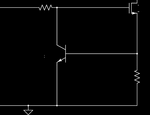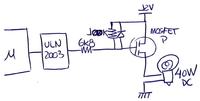Mr. Ohm Smith
Newbie level 4
Good afternoon,
I recently changed a relay to a MOSFET channel P to reduce space and silence the application. The same pin of microcontroller drives mosfet through a totem pole connection. Mosfet switches a 40W DC lamp. Until this point everything works fine.
The problems is: when the lamp is in a short circuit situation, the mosfet BURNS! My application can't afford a high side drive solution. I can't use fuses too, so I need an automatic solution.
Is there another way to protect Mosfet?
Best Regards,
I recently changed a relay to a MOSFET channel P to reduce space and silence the application. The same pin of microcontroller drives mosfet through a totem pole connection. Mosfet switches a 40W DC lamp. Until this point everything works fine.
The problems is: when the lamp is in a short circuit situation, the mosfet BURNS! My application can't afford a high side drive solution. I can't use fuses too, so I need an automatic solution.
Is there another way to protect Mosfet?
Best Regards,


